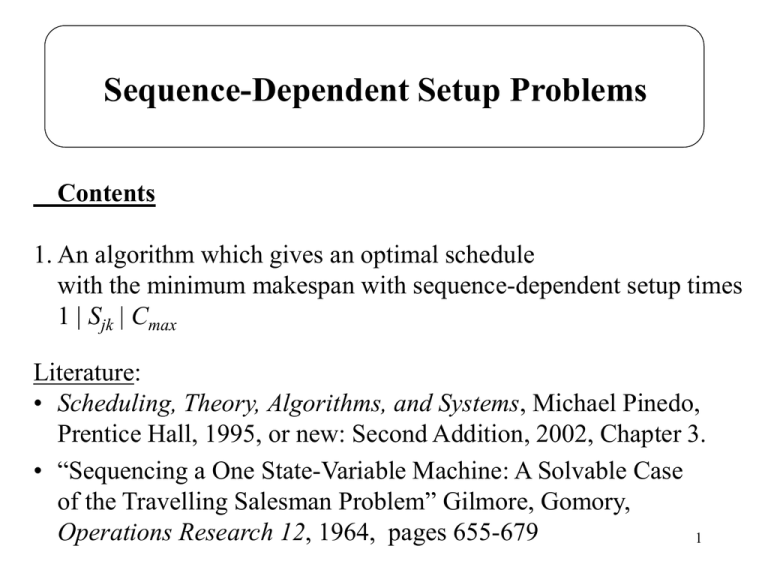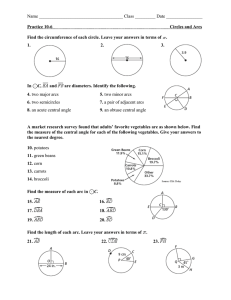15_singlesetup.ppt
advertisement

Sequence-Dependent Setup Problems
Contents
1. An algorithm which gives an optimal schedule
with the minimum makespan with sequence-dependent setup times
1 | Sjk | Cmax
Literature:
• Scheduling, Theory, Algorithms, and Systems, Michael Pinedo,
Prentice Hall, 1995, or new: Second Addition, 2002, Chapter 3.
• “Sequencing a One State-Variable Machine: A Solvable Case
of the Travelling Salesman Problem” Gilmore, Gomory,
Operations Research 12, 1964, pages 655-679
1
Single machine: rj=0, no sequence dependent setup times Cmax p j
j
1 | Sjk | Cmax
NP hard
• a single real variable which describes each job
job j: to start the job the machine must be in state aj ,
at the completion of the job the machine state is bj
sjk = | ak - bj | job k follows job j
• Travelling Salesman Problem
with n+1 cities j0, j1, …,jn, j0
k = (j) travelling salesman leaving city j for city k
2
0
2
3
1
bk
bj
b2
b1
0
2
{0, 1, 2, 3} {2, 3, 1, 0}
(0) = 2
3
1
(1) = 3
(2) = 1
{0, 1, 2, 3} {2, 1, 3, 0}
(3) = 0
a(j)
a(k)
a(2)
a(1)
cost of going from 1 to (1) is | a(1) - b1 |
3
Swap I(j,k) applied to a permutation produces another permutation ’:
’(k) = (j)
’(j) = (k)
’(l) = (l), l j , k
5
5
1
4
4
2
3
6
11
1
7
2
3
6
11
7
8
8
10
9
10
9
4
a(k)
bk
change in cost due to
swap I(j, k)
a(j)
bj
2(b a)
|| [a, b] ||
2(a b)
if
if
ba
ba
Lemma. If the swap causes two arrows that did nor cross earlier
to cross, then the cost of the tour C I(j,k) increases and vice versa.
C I(j, k) = || [bj, bk] [a (j), a (k)] ||
Lemma. Let * be a permutation that ranks a, that is
5
j > k implies a (j) > a (k), then * is optimal with respect to cost.
G undirected graph where arcs link the jth and (j)th nodes, j=1,…,n.
Spanning tree - a minimal set of additional arcs that connect an
unconnected graph.
2
3
1
4
4
6
7
9
10
12
15
9
16
11
4
6
7
13
12
5
8
14
6
7
13
10
3
1
5
8
14
2
3
1
5
8
11
2
15
9
16
11
14
13
10
16
15
12
6
Theorem. Assume that G has p components. Let I(j1, k1), …, I(jp-1, kp-1),
be the swaps corresponding to the arcs of a spanning tree G .
The arcs may be taken in any order. Then the permutation ’ given by
’= I(j1, k1), …, I(jp-1, kp-1)
is a tour.
Lemma. There is a minimal cost spanning tree for G that contains only
arcs Rj, j+1.
7
b3=10
a(3)=11
b2=6
a(2 )=4
b1=1
b3=10
a(1) =2
a(3)=11
b2=6
b1=1
C I(1, 2) = || [1,6] [2,4] ||
= 2 (4-2) = 4
C I(2, 3) = || [6,10] [4,11] ||
= 2 (10-6) = 8
b3=10
a(3)=11
b2=6
a(2 )=4
a(2 )=4
a(1) =2
a(1) =2
I(1, 2) then I(2, 3)
C I(2, 3) = || [6,10] [2,11] ||
= 2 (10-6) = 8
b1=1
I(2, 3) then I(1, 2)
C I(1, 2) = || [1,6] [2,11] || 8
= 2 (6-2) = 8 CHANGED!
A node is of Type 1
A node is of Type 2
if bj a(j)
if bj > a(j)
A swap is of Type 1
A swap is of Type 2
if lower node is of Type 1
if lower node is of Type 2
(arrow points up)
(arrow points down)
If
swaps I(j, j+1) of Type 1 are performed in decreasing order
of the node indices,
followed by swaps of Type 2 in increasing order
of the node indices
then a single tour is obtained without changing any
C* I(j, j+1) involved in the swaps
9
Algorithm + Example
7 jobs
bj
aj
1
7
15
16
26
22
40
18
3
4
19
45
31
34
Step 1.
Arrange the bj in order of size and renumber the jobs so that
b1 b2 ... bn
Arrange the aj in order of size.
The permutation mapping * is defined by
* (j) = k, k being such that ak is the jth smallest of the a.
10
a4=45
b7=40
a6=34
b6=31
b5=26
a5=22
a7=18
a3=16
b4=19
b3=15
a1=7
b2=3
b1=1
jobs
bj
aj
a*(j)
*(j)
1
1
7
4
2
2
3
4
7
1
a2=4
3
15
16
16
3
4
19
45
18
7
5
26
22
22
5
6
31
34
34
6
7
40
18
45
4
11
Step 2.
Form an undirected graph with n nodes and undirected arcs
connecting the jth and *(j) nodes, j=1,…n .
If the current graph has only one component then STOP ;
otherwise go to Step 3.
2
1
3
7
4
6
5
12
Step 3.
Compute the swap costs C *I(j, j+1) for j=1,…,n
C* I(j, j+1) = 2 max ( min (bj+1, a*(j+1)) - max (bj, a*(j)) ), 0 )
C* I(1, 2) = 2 max ( (3-4), 0 ) = 0
C* I(2, 3) = 2 max ( (15-7), 0 ) = 16
C* I(3, 4) = 2 max ( (18-16), 0 ) = 4
C* I(4, 5) = 2 max ( (22-19), 0 ) = 6
C* I(5, 6) = 2 max ( (31-26), 0 ) = 10
C* I(6, 7) = 2 max ( (40-34), 0 ) = 12
13
Step 4.
Select the smallest value C* I(j, j+1) such that j is in one component
and j+1 in another. In case of a tie for smallest, choose any.
Insert the undirected arc Rj, j+1 into the graph. Repeat this step until
all the components in the undirected graph are connected.
2
1
2
1
3
4
7
2
1
3
4
6
5
4
7
4
6
5
4
6
6
10
16
3
4
7
4
6
1
3
4
7
2
5
6
6
5
10
14
Step 5.
Divide the arcs added in Step 4 into two groups.
Those Rj, j+1 for which bj a(j) go in group 1,
those for which bj > a(j) go in group 2.
arcs
R2, 3
R3, 4
R4, 5
R5, 6
bj
b2=3
b3=15
b4=19
b5=26
a*(j)
a1=7
a3=16
a7=18
a5=22
group
1
1
2
2
Step 6.
Find the largest index j1 such that Rj1, j1+1 is in group 1.
Find the second largest index, and so on, up to jl assuming there are
l elements in the group.
Find the smallest index k1 such that Rk1, k1+1 is in group 2.
Find the second smallest index, and so on, up to km assuming there are
m elements in the group.
j1 = 3, j2 = 2,
k1 = 4, k2 = 5
15
Step 7.
The optimal tour ** is constructed by applying the following
sequence of swaps on the permutation *:
** = * I(j1, j1+1) I(j2, j2+1) … I(jl, jl+1)
I(k1, k1+1) I(k2, k2+1) … I(km, km+1)
** = * I(3,4) I(2,3) I(4,5) I(5,6)
Type 1
Type 2
16
a4=45
a4=45
b7=40
b7=40
a6=34
a6=34
b6=31
b6=31
b5=26
b5=26
a5=22
a7=18
a3=16
b4=19
b3=15
b4=19
b3=15
a1=7
a1=7
b2=3
b1=1
a2=4
* I(3,4)
a5=22
a7=18
a3=16
b2=3
b1=1
a2=4
* I(3,4) I(2,3)
17
a4=45
a4=45
b7=40
b7=40
a6=34
a6=34
b6=31
b6=31
b5=26
b5=26
b4=19
b3=15
a5=22
a7=18
a3=16
b4=19
b3=15
a1=7
a1=7
b2=3
b1=1
a2=4
* I(3,4) I(2,3) I(4,5)
a5=22
a7=18
a3=16
b2=3
b1=1
a2=4
** = * I(3,4) I(2,3) I(4,5) I(5,6)
18
a4=45
b7=40
a6=34
b6=31
b5=26
a5=22
a7=18
a3=16
b4=19
b3=15
a1=7
b2=3
b1=1
a2=4
** = * I(3,4) I(2,3) I(4,5) I(5,6)
The optimal tour is:
12745631
The cost of the tour is: 3 +
15 + 5 + 3
+ 8 + 15 + 8
=19 57
Summary
1 | Sjk | Cmax , sjk = | ak - bj |
a polynomial time algorithm is given
1 | Sjk | Cmax is NP hard
20


